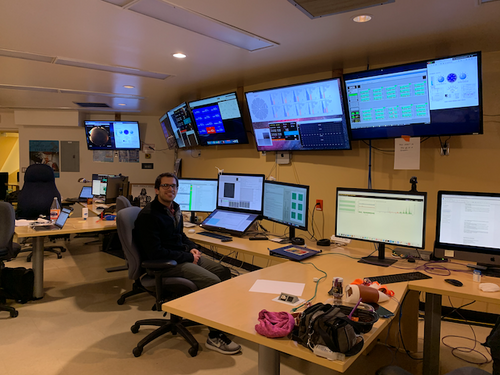
On August 3, 2021 Naim Karacayli successfully defended the thesis: “Improving the Cosmic Statistics of Neutral Hydrogen” (Advisor: Nikhil Padmanabhan).
Karacayli explained, “Dark energy and dark matter are the biggest mysteries of modern cosmology. With the upcoming experiments, we can map the hydrogen at great volumes and learn how it forms structures across the universe. These structures contain clues about the dark components. In my thesis, I focus on experiments that map the neutral hydrogen through its emission and absorption lines. I use computational and theoretical techniques to recover lost data and perform optimal measurements. These techniques will help us unleash the full potential of upcoming data.”
Karacayli will be a CCAPP fellow at the Ohio State University Center for Cosmology and Astroparticle Physics.
Thesis abstract: The study of the large-scale cosmological structure seeks to understand the makings and the evolution of the universe. In this subject, I worked on improving current techniques and their application to the existing large, high-precision cosmological data sets. Specifically, my dissertation explores boosting power spectrum measurements at large scales for 21-cm intensity maps through reconstruction, and at small scales for Lyman-alpha Forest by developing and applying the optimal estimator to hundreds of high-resolution spectra.
The cosmic tidal reconstruction is a novel technique for low redshift (z < 2) 21-cm intensity mapping surveys (e.g., CHIME and HIRAX) that recovers the lost large-scale line-of-sight signal from local small-scale anisotropies formed by tidal interactions. My thesis shows this algorithm is robust against redshift space distortions and can recover the signal with approximately 70 % efficiency for k < 0.1 h/Mpc using N-body simulations. I also introduce an analytical framework based on perturbation theory.
The Lyman-alpha Forest technique can probe matter in vast volumes far into the past (2 < z < 5) and at smaller scales than galaxy surveys (r < 1 Mpc) through absorption lines in quasar spectra. The 1D power spectrum is shaped by the thermal state of the intergalactic medium (IGM), reionization history of the universe, neutrino masses and the nature of the dark matter. Using synthetic spectra, I show the optimal quadratic estimator for P_1D is robust against quasar continuum errors and gaps in spectra, and can improve accuracy beyond FFT-based algorithms for the upcoming DESI data. I also apply this estimator to the largest data set of high-resolution, high-S/N quasar spectra, which yields the most precise P_1D measurement at small scales that can improve the warm dark matter mass constraints by more than a factor of 2.
